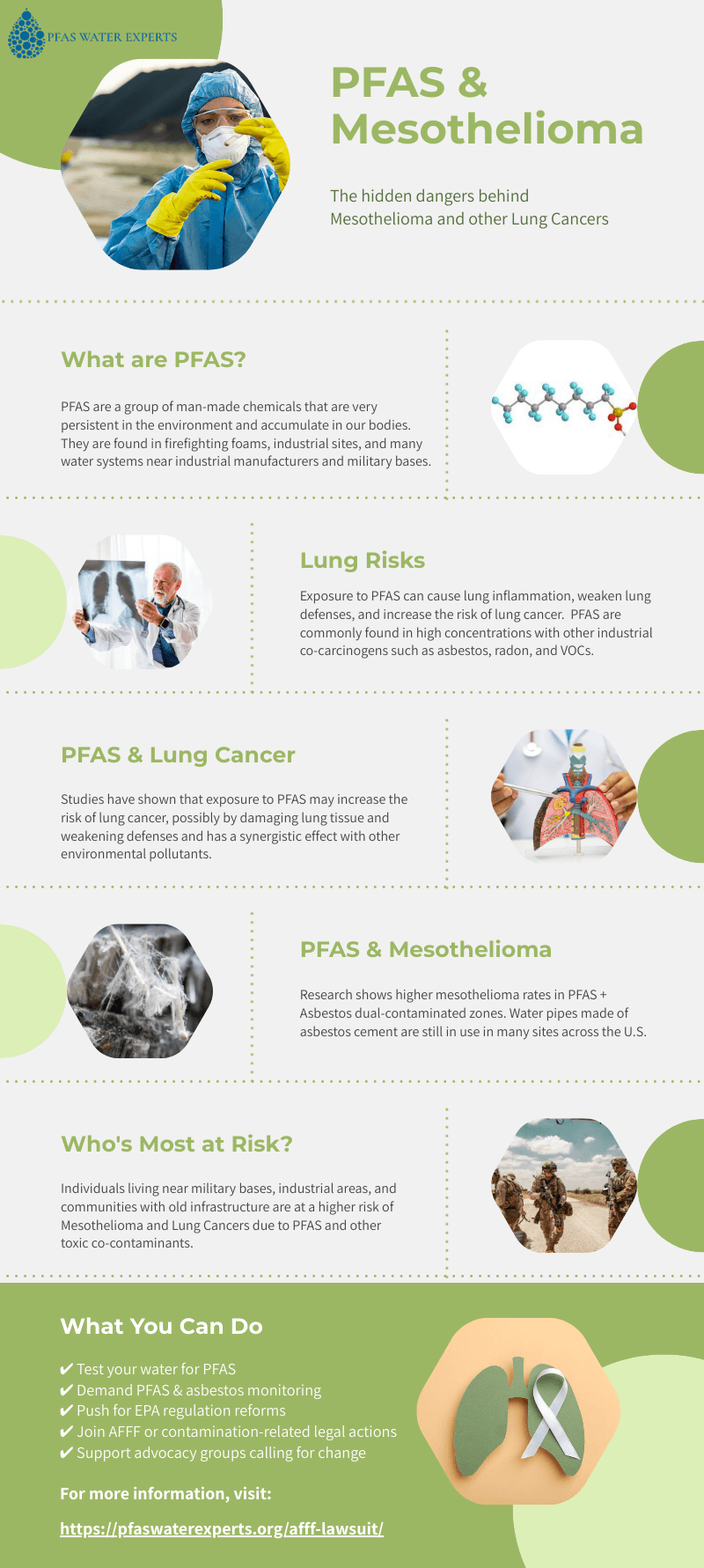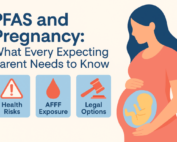Introduction
While public attention has largely focused on PFAS’s links to kidney, thyroid, and testicular cancers, emerging scientific evidence suggests a troubling connection between PFAS and other toxic pollutants in water and increased rates of lung cancer and mesothelioma.
This article explores how toxic chemicals like PFAS—and co-contaminants such as asbestos fibers, heavy metals, and volatile organic compounds (VOCs)—may contribute to respiratory system damage, mesothelial tissue inflammation, and the development of aggressive cancers such as lung cancer and mesothelioma. As legal investigations and public health studies continue to evolve, communities must stay informed, and policymakers must act urgently.

PFAS: An Overlooked Respiratory Threat
PFAS compounds are often referred to as “forever chemicals” because they do not break down in the environment or the human body. They are most commonly known for contaminating water near military bases, airports, and manufacturing facilities where firefighting foams (AFFF) and industrial coatings were used. However, what is often overlooked is that PFAS exposure doesn’t only affect the kidneys or immune system—it also poses risks to the lungs and surrounding tissues.
Studies have found that inhalation and ingestion of PFAS can lead to respiratory tract inflammation, oxidative stress, and DNA damage.
PFAS may also amplify the effects of other carcinogens in water systems, acting as co-carcinogens that enhance the toxicity of asbestos fibers, silica particles, or radon exposure—all known contributors to lung cancer and mesothelioma.
A 2021 study published in Toxics journal highlighted the cytotoxic effects of PFOA and PFOS on bronchial epithelial cells, which play a crucial role in lung cancer pathogenesis.
While this area of research is still developing, it underscores a critical need to investigate PFAS’s potential as a lung carcinogen.
Co-Contaminants: PFAS and the Asbestos Connection
Many of the regions affected by PFAS contamination also suffer from legacy pollutants like asbestos, arsenic, and silica, especially in older infrastructure or former industrial zones. In some cases, asbestos-containing cement water pipes (ACPs) still deliver drinking water to U.S. neighborhoods.
When PFAS and asbestos co-exist in water systems, they may work in synergy to amplify respiratory and mesothelial tissue damage. Though asbestos exposure through water is less commonly studied than inhalation, fragments can become airborne during maintenance or decay of old pipes, entering homes and posing inhalation risks.
Furthermore, some manufacturing facilities responsible for PFAS discharge were also historical users of asbestos-containing materials (ACMs). This overlap raises concerns about multi-route exposure in vulnerable populations—especially in military families, industrial workers, and low-income communities.

Emerging Evidence Linking PFAS and Lung Cancer
Recent toxicological studies have begun drawing clearer lines between PFAS exposure and cellular changes linked to lung cancer. A 2023 research paper in Environmental Research found that mice exposed to PFOA developed lung inflammation and pre-cancerous lesions, while PFOS exposure was associated with immune suppression in pulmonary tissue.
While PFAS has not yet been definitively classified as a lung carcinogen by the International Agency for Research on Cancer (IARC), the mechanisms are biologically plausible:
- Oxidative stress in bronchial tissue
- Immune dysregulation in the lung microenvironment
- DNA damage and epigenetic changes in alveolar cells
Researchers have also warned that PFAS may weaken lung defense barriers, making individuals more susceptible to damage from smoking, radon, or industrial air pollution—known co-risk factors for lung cancer.
Mesothelioma and Environmental Co-Exposure Risks
Mesothelioma, an aggressive cancer of the mesothelial lining (typically in the lungs), is almost exclusively linked to asbestos exposure. However, environmental co-contamination with PFAS could act as an exacerbating factor, accelerating disease progression or amplifying immune suppression that weakens the body’s ability to fight tumor formation.
A small-scale cohort study conducted by researchers at the University of Michigan in 2022 noted significantly higher mesothelioma incidence in communities with both known asbestos groundwater contamination and elevated PFAS levels.
Although causation was not conclusively established, researchers urged federal agencies to treat multi-chemical exposures as serious and synergistic health threats.
Communities at Risk: Who’s Being Affected?
Thousands of U.S. communities may be simultaneously exposed to multiple carcinogens via water systems, particularly:
- Military bases and surrounding neighborhoods
- Rural communities with aging asbestos-cement infrastructure
- Industrial towns with chemical manufacturing histories
- Low-income urban areas lacking modern water filtration systems
Unfortunately, these are often the same communities with the fewest resources to fight back, advocate for cleanup, or access specialized cancer screening services.
Furthermore, recent environmental assessments have identified both PFAS and asbestos co-contamination in soil and groundwater on several U.S. military bases, increasing concern about compounded cancer risk.
For example:
- Fort Ord (California) has documented asbestos in soils near demolition zones and concurrent PFAS detections in groundwater sampling reports.
- Naval Air Station Joint Reserve Base Willow Grove (Pennsylvania) and Naval Air Station Fallon (Nevada) have both reported dual PFAS and asbestos contamination in EPA site reports and military environmental assessments.
This growing body of evidence highlights the urgent need for multi-contaminant testing protocols and remediation strategies that address the combined toxic burden affecting vulnerable populations, especially veterans and their families. that address the combined toxic burden affecting vulnerable populations, especially veterans and their families.
Call to Action: What Needs to Be Done
- Comprehensive Testing: Water utilities must be required to test not only for PFAS but also for legacy carcinogens like asbestos, VOCs, and heavy metals.
- Transparency: Utilities and state health departments must publicly disclose contamination levels and potential co-risk factors.
- Stronger Regulations: EPA must accelerate its regulatory limits for PFAS and initiate new rules for asbestos in drinking water infrastructure.
- Veteran & Worker Protections: Given the overlap in affected populations, veterans and industrial workers must be prioritized for health screenings and legal compensation.
- Join AFFF or Contamination-Related Legal Actions: Victims should be informed of their rights to participate in AFFF lawsuits or class action claims tied to contaminated water.
Conclusion
The toxic synergy of PFAS, asbestos, and other contaminants in drinking water may be an overlooked driver of rising lung cancer and mesothelioma rates in certain populations. As the science progresses, there is little doubt that these chemicals are more dangerous in combination than in isolation. It’s time for urgent reform, transparent communication, and justice for those who have unknowingly lived and worked in harm’s way.
Communities must stay informed, demand action, and hold polluters and public agencies accountable—not just for water contamination, but for the deadly diseases it continues to cause.






